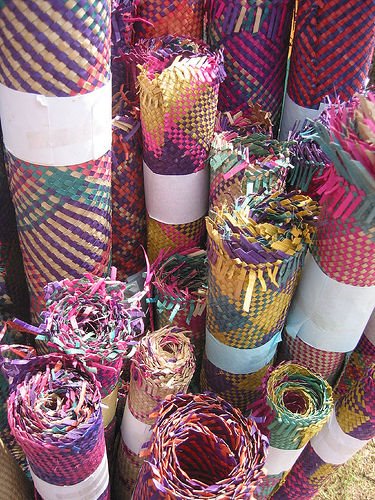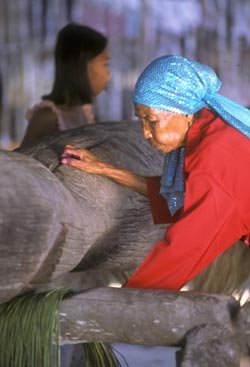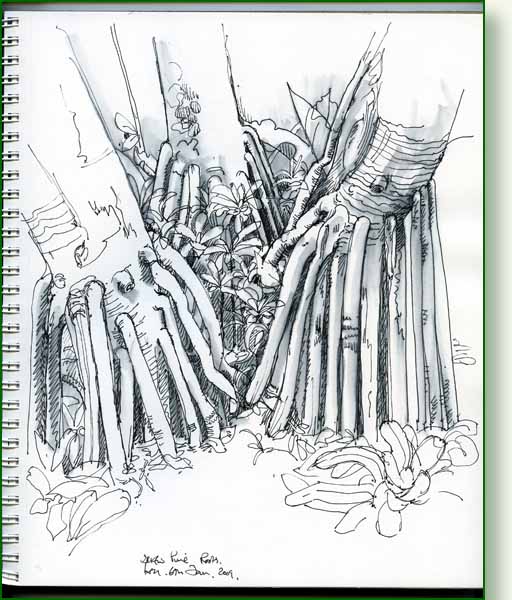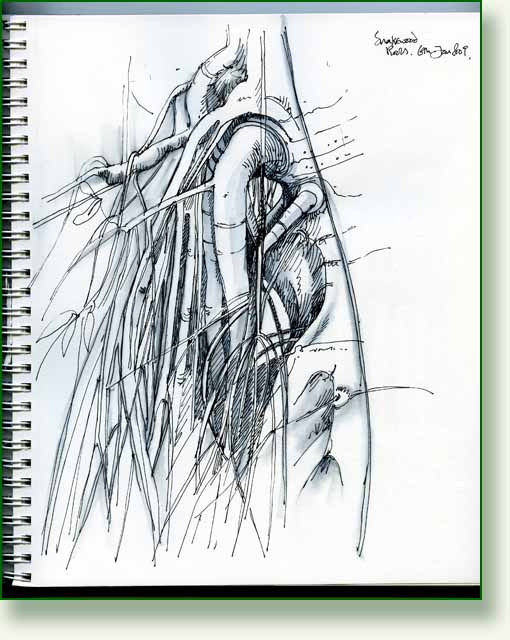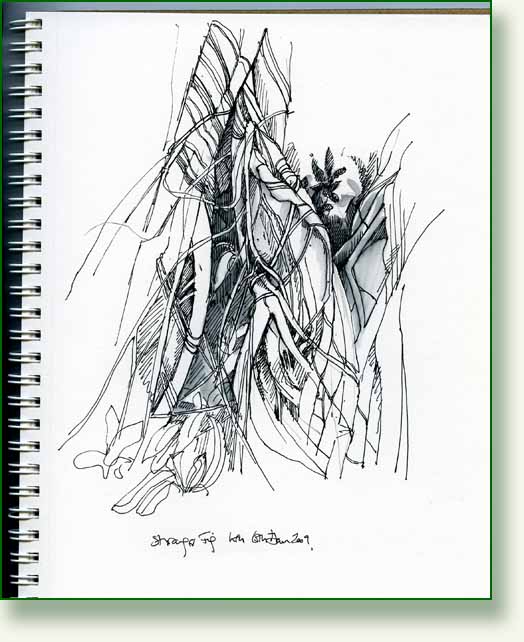These are the root sketches from yesterday, the Snakewood again, the Screwpine Pandanus utilius, and some Strangler Fig roots.
Having done some quick research today on the Screwpine I see that the tree at Leu is just a small one with very modest stilt roots. It also seems that it will have spectacular “edible” fruit,
and its leaves are used for weaving beautiful mats and baskets in India and Indonesia.
One curious little tradition from North Maluku in Indonesia requires a woman to be able to weave screwpine leaves before getting married, as she will not only weave a marital outfit, but also give the groom 3 screwpine mats in acceptance of his proposal.
Here are some “pandan” mats from Farls blog “Photojourneys” here. His photos of the Phillipines are beautiful, it makes me want to get a plane ticket and go! He writes, The Philippines claims to produce the handsomest mats in Asia and arguably the most colorful and intricate fine-grained mats are handwoven by the Samal tribe of Tawi-Tawi.
These lovely mats are, at their most expensive about $20.
The following is an extract from from an article in “The Courier” Unesco’s online newsletter,(here) about one of the best traditional weavers in the Phillipines, Haja Amina Appi.
“Mat weaver Haja Amina Appi walks with a strong stride that betrays her 80 years. She is off to harvest leaves from the pandan trees that grow behind her home in Ungos Matata, in the province of Tawi Tawi, a small island in the southwestern tip of the Philippines. 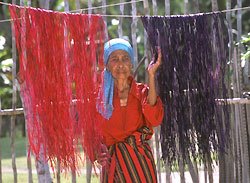
The bulky leaves are thorny-edged, but she prefers this variety because it produces strong and sturdy matting strips. She has become accustomed to the prickly thorns after years of working with them to produce the raw materials of her art. Throughout her life she has been a mat weaver, teacher, artist, and most recently, a National Living Treasure or Gawad sa Manlilika ng Bayan Awardee. A mat can take up to two months to weave, even longer for more intricate designs.
Her work begins with the harvest of the pandan leaves. She then removes the thorns with a small knife and and strips them with a jangat deyum, a thin piece of wood with sharp tines. The resulting narrow ribbons are then sun-dried and colored in a boiling vat of anjibi, a commercial powdered dye.
To soften the strips and make them pliant enough for weaving, she crushes them repeatedly with a paggosa or heavy log, in a process called pagtabig. This arduous and repetitive chore is essential to properly dry the pandan strips without rendering them brittle and useless.
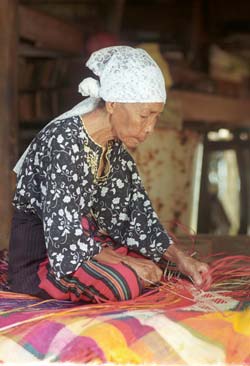
photos Renato S. Rastrollo
Haja Appi is famous for her even weaves and the creativity of her designs.
She does not work from a written pattern, nor does she use paper and pencil to keep track of each loop and fold. She relies on her innate sense of mathematical progression to calculate when and how the colored fibers will eventually join to create symmetrical geometric designs.What sets Haja Appi apart from her fellow mat weavers is the exceptional evenness of her weave and the startling creativity of her patterns. Although she uses a traditional repertoire of weaving techniques to create delicate, precise, and minutely detailed patterns, her simple geometric designs are dramatic bursts of color that both defy and celebrate tradition. “
I really love these traditional crafts which use natural materials and only hope that they can be sustained. Our society seems to be obsessed with needing to have more and more piles of cheap and tacky ‘things’. Surely one beautiful handwoven mat is worth 50 cheap mass produced synthetics? But the drive to show off the quantity of possessions, cheap or expensive, seems to be hardwired into many. Does it actually make people feel better? The sheer volume of really horrible decorations here, which spewed out of every gift shop before Christmas was staggering. Clogging up the shops one day, in the rubbish bins the next, but I suppose it keeps all the factories in China busy. (small rant, brought on by the news of the heartbreaking demise of first Royal Worcester and now Wedgwood, two of the great fine china factories in the world.. I just can’t believe it. It all makes me terribly sad.)
These sketches are done on a 8×10 inch sketch book with a black pen that will run a bit if you add water..which makes sketching easy and quick. All you need is sketchbook book, pen, brush and water…sometimes just sketchbook and pen will do, as spit (sorry) and fingertip will give you some smudging. Improvisation is the friend of the impoverished artist.
The pen is good for confidence in drawing because there is no prelim pencil work and no rubbing out, just straight in with the pen, you can’t fuss about with it. Worrying about incorrect lines is pointless and anyway if a root is a bit askew who’s to know. You can get way with an slightly misplaced root whereas an arm or leg wrongly positioned can be more serious.
__________________________________________

